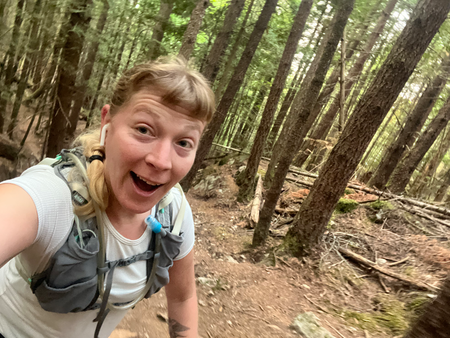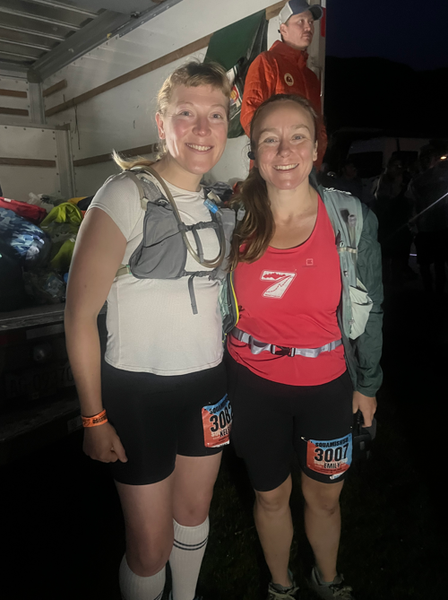
In 2014, at the age of 24, I started running. In 2018, I competed in my first marathon. In 2019, I competed in my first ultra-marathon. Since then, I have run the San Francisco (road) marathon, six trail races at the 50-kilometer distance, five trail races at a 50-mile distance, and one 100-mile race.
This year, I’ve been transitioning from a solo ultra-runner to a team-oriented mountaineer. In October, I reworked my year-long runner’s training plan to incorporate elements that would allow me to be successful in the Seattle Basic Alpine Climbing course. My hope was that the physical fitness of mountaineering would translate well to ultra-running and vice-versa. This idea will be put to the test in September when I run a 100-mile race in the Oregon woods called the Mountain Lakes 100. When I ran the race in 2022, I completed it in 29.5 hours. With my new mountaineering-informed training plan, I’m aiming to finish in 23.5 hours.
Mountaineering to run
Pre-dawn starts, double-headlamp days, sketchy river crossings, and a lot of salty snacks are some of the commonalities between ultra-running and mountaineering. 15.5-hour days are common in mountaineering, even if 50-mile routes are not. Taking dangerous conditions into account and understanding the limits of my physical safety are just a few of the practices I’m learning to carry between mountaineering and running.
As part of the 100-mile Mountain Lakes training plan, I test my fitness with a 50-mile race in August.
I’m in “Beautiful British Columbia” and the province is cloaked in a thick layer of forest fire smoke. The air quality is “unhealthy for sensitive groups,” with an Air Quality Index (AQI) score of 80-100. It's hot and dry. There are ground wasps everywhere. I’m on a switchback, going uphill on legs that have already covered thousands of feet of elevation change and over 43 miles of roads, hiking trails, and technical mountain bike trails. The smoke is making me sick to my stomach and torturing me with a migraine. This late in the race it’s Punk-Rock-O-Clock and I’m tuned into up-tempo songs to get me through the last segment. Even blasting The Clash through my single air-pod isn’t enough to power through. I’m struggling to turn over my legs, pumping hard and getting nowhere.
This weekend is supposed to be a two-day running adventure: completing the Squamish 50-mile race on day one, and the Squamish 50k race on day two. This particular form of sadism is called the Squamish 50/50. I did it last year, and signed up to do it again.
The Squamish 50/50 is a burly course with some serious ‘vert’ and decent cell reception. My boyfriend (Chad) and best friend (Emily) are relaxing at the hostel as I finish the last segment of the race. At mile 33, I mentally thank (or curse) Emily, another Mountaineer, for getting me into this glorious sport. By mile 43 I’m desperate for some encouragement. My texts to Chad go as follows:
Kelsey: 6:40pm, mile 43 - “I’m in rough shape.”
Chad: “You got it!!!! Final push.”
Kelsey: 8:14pm, mile 48 - “Can you meet me at the finish line? Maybe with the car?? I feel like garbage.”
Chad: “We got you!!!”
I finish the 50-mile race in 15.5 hours, an hour faster than my previous record. My method was to go slow and steady to preserve energy for the next day’s race. But, alas, I bail on the 50k. For the first time ever, I “no-show” a race.
 Kelsey (left), and Emily (right) have been friends since before they were Basic Alpine Climbing Course Students
Kelsey (left), and Emily (right) have been friends since before they were Basic Alpine Climbing Course Students
Knowing the limits of your “ultra”
The lesson I’m learning from mountaineering is the art of knowing when to say “no” to a trip. As I experience the difficulties of planning for mountaineering trips, getting excited, filling out permits, and then watching as a weather window closes or a storm blows in, I’m also learning to interact with ultras in a different way. Ultras are known for their extreme conditions, and that doesn’t mean that I must run them. Ultras are notorious for continuing forward despite excessive heat warnings, atmospheric rivers, and early winter storms. I would argue that ultras are “ultra” because of their propensity for taking an already grueling sport and making it more challenging. As I continue to engage with The Mountaineers, I’m learning how to be more conscientious about the types of challenges I take on as an ultra-runner.
If you’re a mountaineer considering ultra-running, choose your races like you choose your climbs. Know your skill level and willingness to suffer. If you love a forested trail and despise scrambles, choose races accordingly. If you wouldn’t climb in that weather, or in that smoke, maybe you don’t need to run in it either.
I didn’t push myself to complete a 50k after a hard 50 miles because it was too much. The smoke was too much (“unhealthy” with an AQI of 200), the stress on my body was too much (don’t get me started on the chafing), and I was under-trained for my goal (I was aiming for 15-minute miles and running an average of 18.6). I said “no” to the second day of racing, and just like when I’ve had to decline Mountaineers trips for illness, weather, and life events, I’m working to accept the change of plans and embrace the surprise rest day.
I choose to take part in races like I choose how to show up to mountaineering trips. It is easy to forget that an ultra race is about more than making choices for one race and one runner. Like mountaineering trips, ultra races are about making good choices for the team of people who love and support each runner. As a runner and a mountaineer, your choices are about maintaining your health, knowing your limits, and choosing wisely for the conditions. Knowing and understanding these choices has been a powerful mental cross-training element that keeps me thriving in the alpine and on the trails.
 Kelsey Hoffman
Kelsey Hoffman